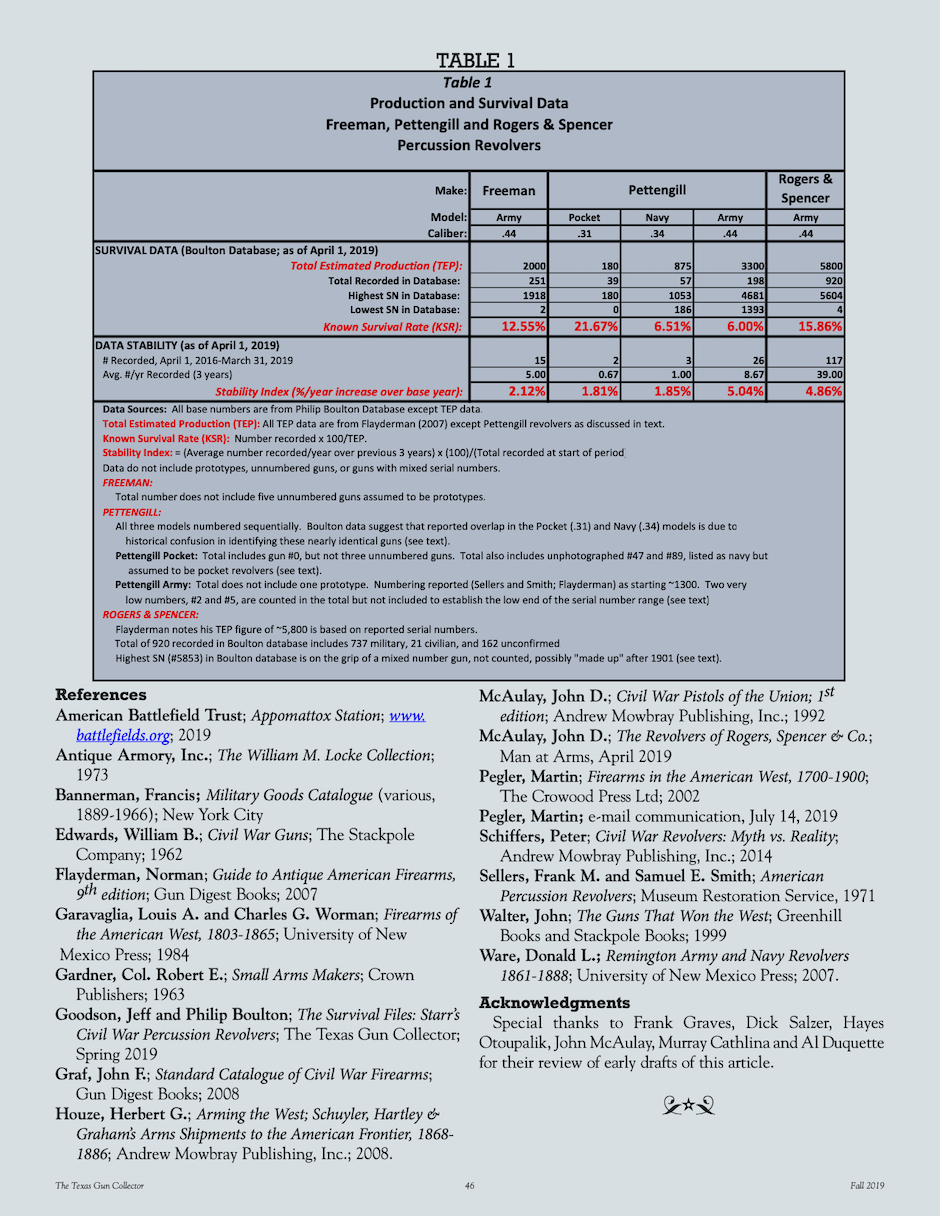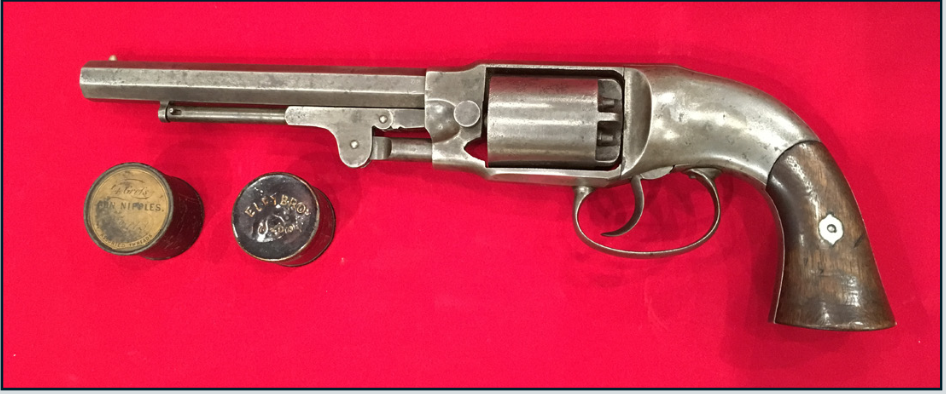|
Survival Files #2examines the survival of three Civil War revolvers—the Freeman, Pettengill and Rogers & Spencer. These guns have deep historical linkages. The Rogers family started making single-shot percussion pistols in the late 1840s, and formed the company Rogers & Spencer about 1861 in Willow Vale, New York. It made all three models of Pettengill revolvers, it secured patent and manufacturing rights to the Freeman revolver, and it incorporated elements of both into its own patented firearm. Today, the Rogers & Spencer is considered one of the best revolvers of the percussion era. The Freeman Revolver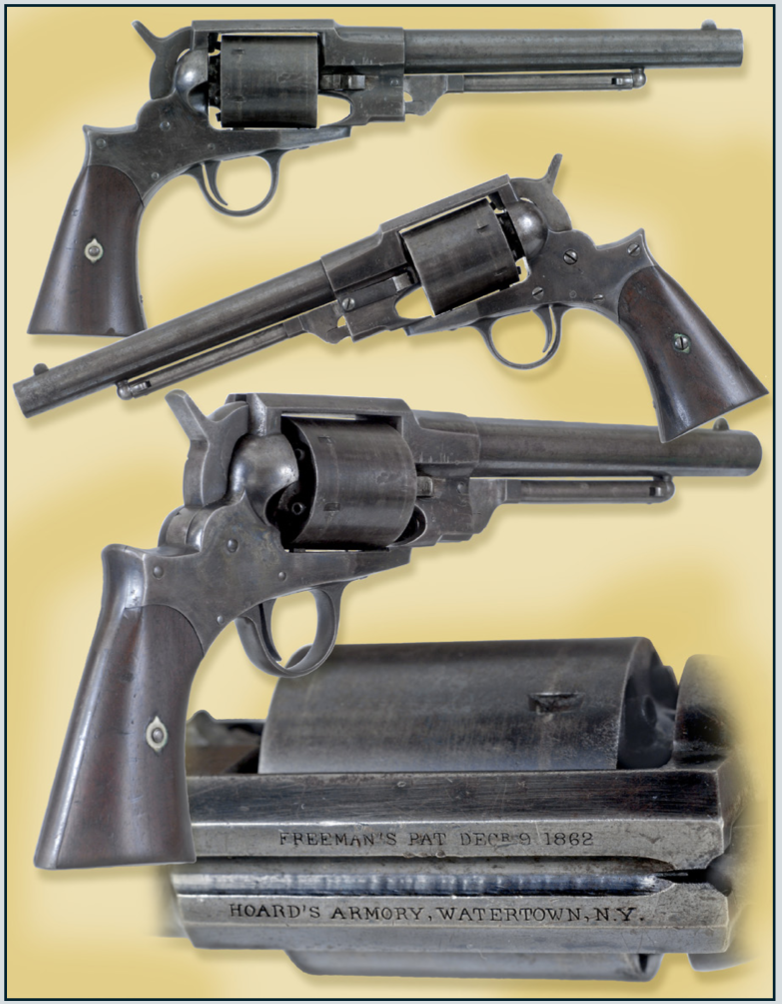
Austin T. Freeman started working for the Starr Arms Company about 1861 (McAulay). While there, he developed a .44 caliber percussion revolver that was similar in certain respects to the Starr and Remington revolvers It included Freeman’s patented design for a cylinder-axis pin and locking catch that allowed removal of the cylinder from the left side of the gun. (Figure 1) Hoard’s Armory of Watertown, New York made the Freeman from 1863-1864 (Edwards). |
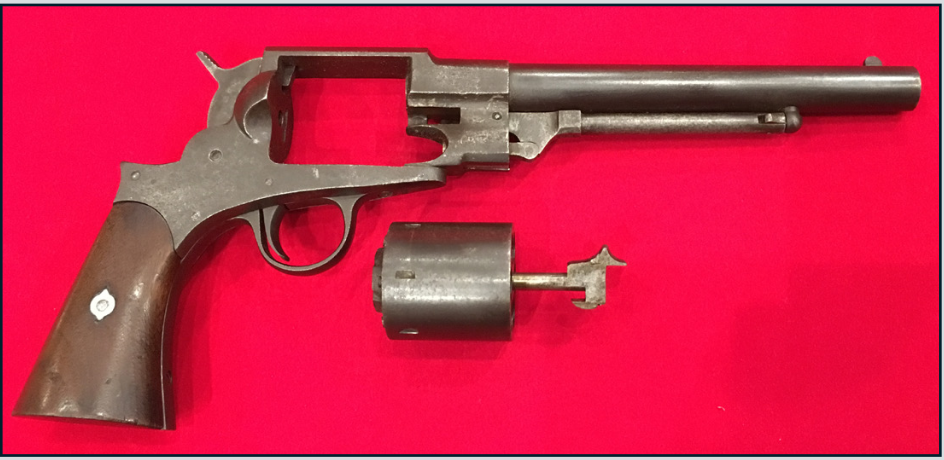 Figure 1: Freeman .44 percussion revolver (#663). Note Freeman-patented cylinder axis pin and locking catch. GOODSON COLLECTION.
Figure 1: Freeman .44 percussion revolver (#663). Note Freeman-patented cylinder axis pin and locking catch. GOODSON COLLECTION.
Total Production. The Ordnance Department contracted with Hoard to make 5000 Freeman revolvers in 1863, but there were numerous problems with production. Hoard eventually produced about 2000 guns (Flayderman; McAulay 2019), none of which were delivered against the contract. A subsequent contract, also for 5000 guns, was cancelled when the two samples Hoard submitted for approval were rejected by Army inspectors. About this time, Rogers & Spencer secured Freeman’s patent and manufacturing rights (Gardner; McAulay 2019). The Boulton database recorded 251 Freeman serial numbers as of April 1, 2019, ranging from #2 to #1918 (Table 1 - see page 46). This suggests a total factory production of about 1920 guns vs. the 2000 reported. That’s a significant discrepancy—80 guns—and those who encounter Freeman serial numbers above 1918 are urged to send them to Phil Boulton. The number recorded rose at just 2.1% per year over the previous three years, so relatively few unrecorded examples remain to be discovered. Survival Factors. While none of the circa 2000 Freeman revolvers were delivered against U.S. government contracts, Ordnance Department ledgers contain ‘numerous entries for small lots of revolvers purchased on the open market during the early days of the war, including Freemans’ (Ware). Some of the 2000 were also possibly acquired under state contracts (Flayderman), and Schiffers writes that ‘...it is extremely likely that privately owned Freemans found their way into active service.’Freeman revolvers were sold commercially in 1864-1865 (Walter). One story holds that when the Hoard Armory went into receivership after the war, they became part of the assets of the reorganized firm. |
|
‘They were stored in kegs in a
carriage house attic, and the son of one of the receivers sold them in the public square at Watertown for a quarter each’ (McAulay 1992).
There is no record that any Freemans were shipped, either domestically or overseas, by Schuyler, Hartley & Graham from 1868-1886 (Houze). Limited use of Freemans during the Civil War, and the likelihood that they were sold off individually in the eastern United States, helps account for their relatively high survival rate of about 12.6%. The Three Pettengill RevolversThree models of Pettengill revolver were made from 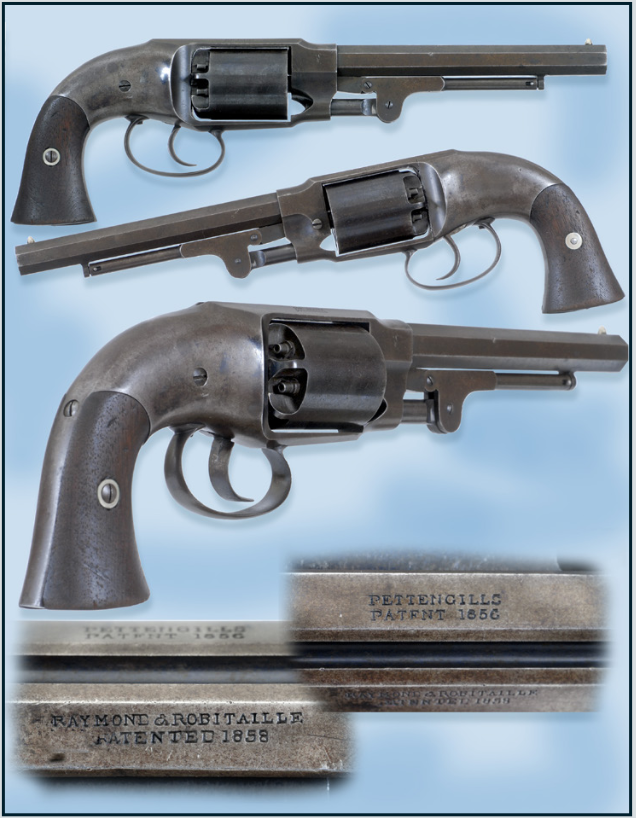 The Army model
The Army model 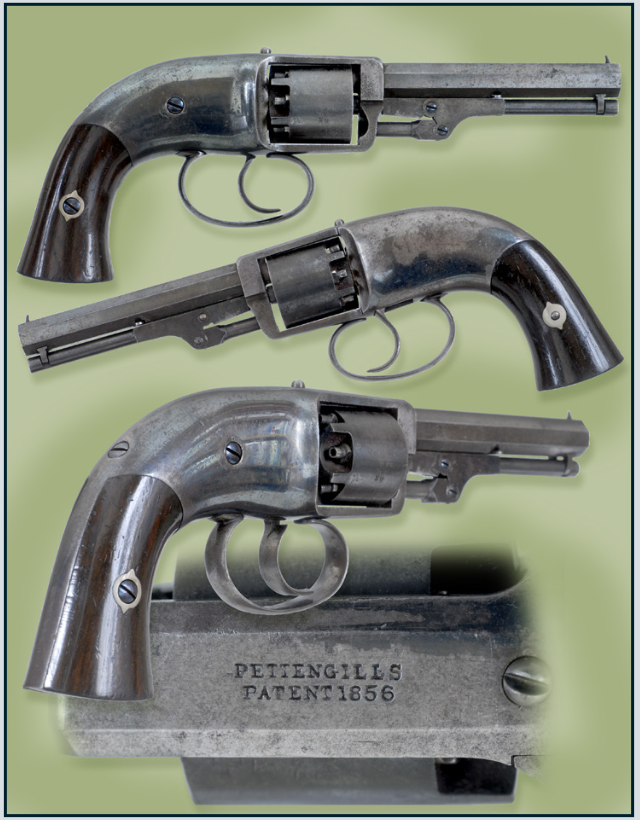 The Navy model
The Navy model Photograph by Ron Paxton |
the late 1850s to the early 1860s—the .31 caliber Pocket, .34 caliber Navy (Figure 2) and .44 caliber Army (Figure 4). Except possibly for a few very early experimental pieces, all Pettengills were made by Rogers & Spencer.
Total Production. In 1971, Sellers and Smith estimated production of the Pettengills at 415 for the Pocket, 900 for the Navy, and 3410 for the Army. Flayderman has consistently reported production at about 425, 900 and 3400, respectively. Based on 294 Pettengill serial numbers in the Boulton database, we now estimate total production for the Pocket at just 180 guns, the Navy at about 875 guns, and the Army at about 3300 guns (Table 1).  Figure 2: The nearly identical small frame Pettengill revolvers. The .34 caliber Navy model is above (#371), and the .31 caliber Pocket model is below (#95). Note the greater width of the Navy frame at the yoke, as well as the slightly longer cylinder and cylinder cavity. GOODSON COLLECTION.
Figure 2: The nearly identical small frame Pettengill revolvers. The .34 caliber Navy model is above (#371), and the .31 caliber Pocket model is below (#95). Note the greater width of the Navy frame at the yoke, as well as the slightly longer cylinder and cylinder cavity. GOODSON COLLECTION.
The Pettengill Telegraph Revolver Company was established by August 1857 (Figure 3). Sellers and Smith write that the first Pocket Pettengills, made for the investors by Rogers & Spencer, ’...were more or less experimental and made in small batches with constant improvements.’ They distinguish three types of pocket gun based on differences in frame material and loading levers, and report a very large overlap of serial numbers among 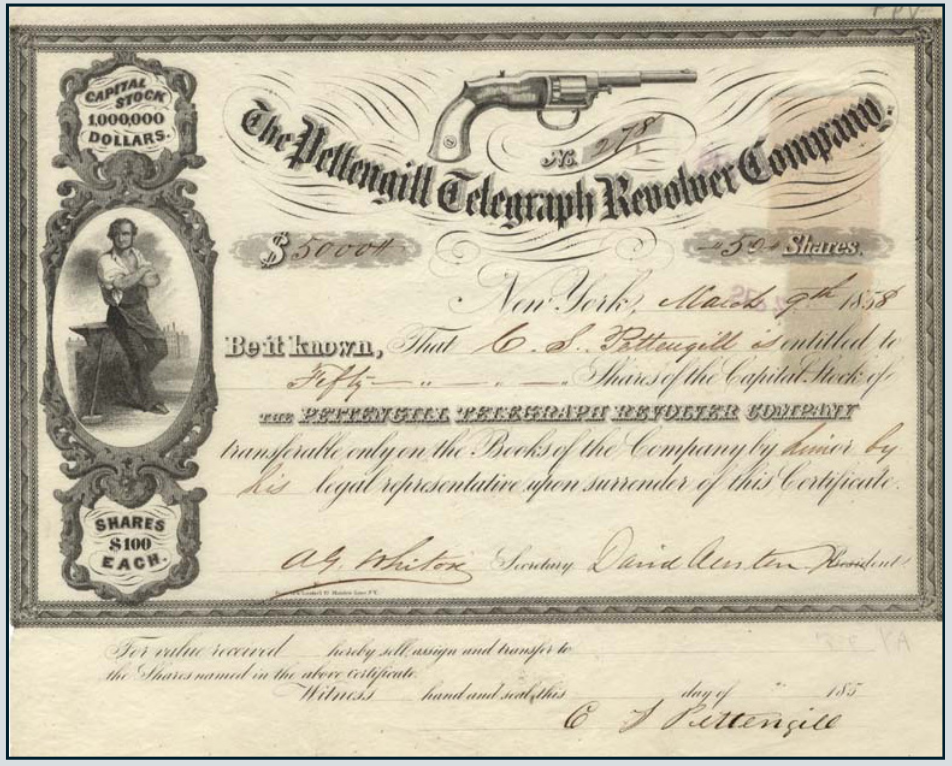 Figure 3: 1857 Stock Certificate #180 for the Pettengill Telegraph Revolver Company. When the investors defaulted, Rogers & Spencer took over the patents and production. Except for a few early specimens, all three models of Pettengill were manufactured by Rogers & Spencer.
Figure 3: 1857 Stock Certificate #180 for the Pettengill Telegraph Revolver Company. When the investors defaulted, Rogers & Spencer took over the patents and production. Except for a few early specimens, all three models of Pettengill were manufactured by Rogers & Spencer.
|
|
them—essentially shoehorning 415 guns into a serial number range ending with #180. With one exception, however, the Boulton database shows zero duplication within the 0-180 range. That exception, #51, is reported for both a plain and an engraved gun, and needs confirmation.
The problem, we believe, is one of mistaken identity dating back to the early 1970s. Without a side-by-side comparison, it’s very easy to confuse the .31 pocket and .34 Navy Pettengill revolvers. Reference to Figure 2 above will show that the two guns are nearly identical in size, caliber, construction and appearance. Sellers and Smith write that ‘while the pocket revolvers were being made, it was decided that a more powerful revolver was needed. The pocket was therefore remodeled by increasing the caliber to .34, and the cylinder length from 1.5 to 1.7 inches’. What they don’t mention is that the cylinder cavity and the frame had to also be lengthened to accommodate the longer cylinder. The increase in the frame length shows up in the length of the yoke. A comparison of two specimens in the Goodson Collection (#95 and #371) show that the cylinder cavity is about .11” longer, and the yoke about 0.18” longer, on the Navy than on the pocket. We believe that the longer yoke on the Navy is a consistent and definitive diagnostic for distinguishing the two models. It is also clearly visible in photographs. The Boulton database records 39 pocket and 57 Navy serial numbers. Three specimens (#19, #44 and #63), originally described in sales records as Navy models, turned out on re-inspection of the photos to be pocket guns. Conversely, in the William M. Locke Collection (Antique Armory, Inc.), both #197 and #679 are Navy models misidentified as pocket guns. Based on differentiation of the two models from the length of the yoke, and lack of photographic evidence for any other overlapping of serial numbers between them, two un-photographed guns in the Boulton database (#47 and #89) were recorded as pocket models. Boulton’s serial number range for the pocket is #0-#180, and for the Navy is #186-#1053 (Table 1). Based on these data, we conclude that total production of the pocket was about 180; production of the Navy began around #185; and there is no overlap in serial numbers between the two as reported by Flayderman. We welcome data that either supports or refutes these conclusions, and urge readers who encounter small frame Pettengills to send serial numbers and photographic evidence to Phil Boulton. Total production for the Pettengill Army is less confused. Rogers & Spencer took over the patents and production of Pettengill revolvers when the investors defaulted, and secured a government contract for 5000 Army guns (Figure 4) in January 1862. Scaling up to .44 caliber, however, proved far more difficult than the company anticipated at the time (McAulay 2019). |
The Ordnance Department refused to inspect the first 1100 Army Pettengills, and the contract for 5000 was reduced to 2000 in June 1862 when test trial problems arose. Over the next seven months, just 2001 Pettengill guns were delivered and accepted (McAulay 2019). A second contract for 10,000 followed in April 1863, but no deliveries were ever made against it. In addition to the 2001 martial guns, about 1300 guns were made for the civilian trade. These probably included the 1100 first production revolvers, and most of about 300 contract guns later rejected by the U.S. Army (Sellers and Smith).
The Boulton database includes 198 Army revolvers ranging from #1393-#4681. The Navy and Army were therefore also numbered sequentially. With one caveat, there are no serial numbers above #1053 for the Navy, or below #1393 for the Army. We therefore estimate the range for the Navy at about #185-#1060 (875 guns), and the range for the Army at about #1390-#4685 plus a handful of single-digit Army guns (3300 guns total). The caveat consists of two extreme anomalies reported by Sellers and Smith for the .44 Pettengill—#2 and #5. These are included in the Boulton database totals, but not used to establish the low end of the serial number range since there are no other examples below #1393. These anomalies may have been pre-production test guns. Survival Factors. Known survival rates for Pettengill revolvers as of April 2019 are about 21.7% for the pocket, 6.5% for the Navy, and 6.0% for the Army model. New specimens were recorded at a rate of about 1.8%, 1.8% and 5.0% per year, respectively, over the previous three years (Table 1). These data indicate that very few unrecorded pocket and Navy guns remain to be discovered. This is in contrast to the Army model, where unrecorded specimens are still relatively common. That the survival rate of the pocket is over three times that of the Navy suggests that the .31 caliber gun saw very little action in the Civil War. Factors which may account for this include rarity; a very short production period; the end of production well before the onset of hostilities; insufficient power; wider availability of the more powerful .34 caliber Pettengill at the outset of the war; and wider availability of the .44 caliber Pettengill—and many other |
|
models—by 1862. That the survival rate of the pocket is over three times that of the Navy suggests that the .31 caliber gun saw very little action in the Civil War. Factors which may account for this include rarity; a very short production period; the end of production well before the onset of hostilities; insufficient power; wider availability of the more powerful .34 caliber Pettengill at the outset of the war; and wider availability of the .44 caliber Pettengill— and many other models—by 1862. The Army Pettengills saw extensive action starting in late 1862, and today most exhibit considerable use (Edwards). By June 1863, over 1100 were listed in field service with the 3rd Michigan, 1st Arkansas (U.S.), 3rd Illinois, 3rd Kentucky, 3rd and 5th Missouri State Militias, and Veteran Reserve Corps (McAulay 1992; 2019). Some of the surplus guns resulting from government contract changes were also apparently purchased by state militia units (Sellers and Smith). Recorded Civil War losses of the Pettengill Army include capture by Confederate forces, battlefield losses and firearm failure. Several authors have written about the poor quality of this revolver (McAulay 2019; Edwards; Garavaglia and Worman). Among other problems, it was liable to jamming, the trigger was prone to bending, and the cylinder was easily fouled. Sellers and Smith note that it: “...suffered one of the highest rejection rates of any revolver during the Civil War. Government inspectors rejected over 15% of all submitted for inspection, not counting the first 1100 made.” In 1865, at least 92 martial Pettengills went home with Union soldiers—91 with the 1st Arkansas, and one from the 5th Missouri (McAulay 2019). After the war, two large disposals of martial Pettengills occurred. The St. Louis Arsenal sold 196 in October 1876, and the New York Arsenal sold 526 in July 1882 (McAuley 1992; 2019). The minimum Civil War survival rate for all U.S. martial Pettengill revolvers was therefore 40.7%. This compares to Civil War survival rates of 31.9% for the .36 caliber Starr and 64.2% for the two .44 caliber Starr revolvers, as reported in Survival Files #1. There is no record that any Pettengills were shipped by Schuyler, Hartley & Graham from 1868-1886 (Houze). The Rogers & Spencer Revolver Rogers & Spencer made a revolver of its own ‘under the Freeman patent’ from 1864-1865. That .44 caliber, 6-shot, single action gun (Figure 5) considered one of the best percussion revolvers of the era. It used some of the same parts used in making the Pettengill army, including barrels, loading levers and front sights, and it was apparently made on Pettengill revolver machinery (McAulay 2019). Total Production. Total production is widely reported at 5800. Under a November 1864 contract, 5000 were delivered to the New York Arsenal from January-September 1865 (McAulay 2019). Flayderman writes that the balance of about |
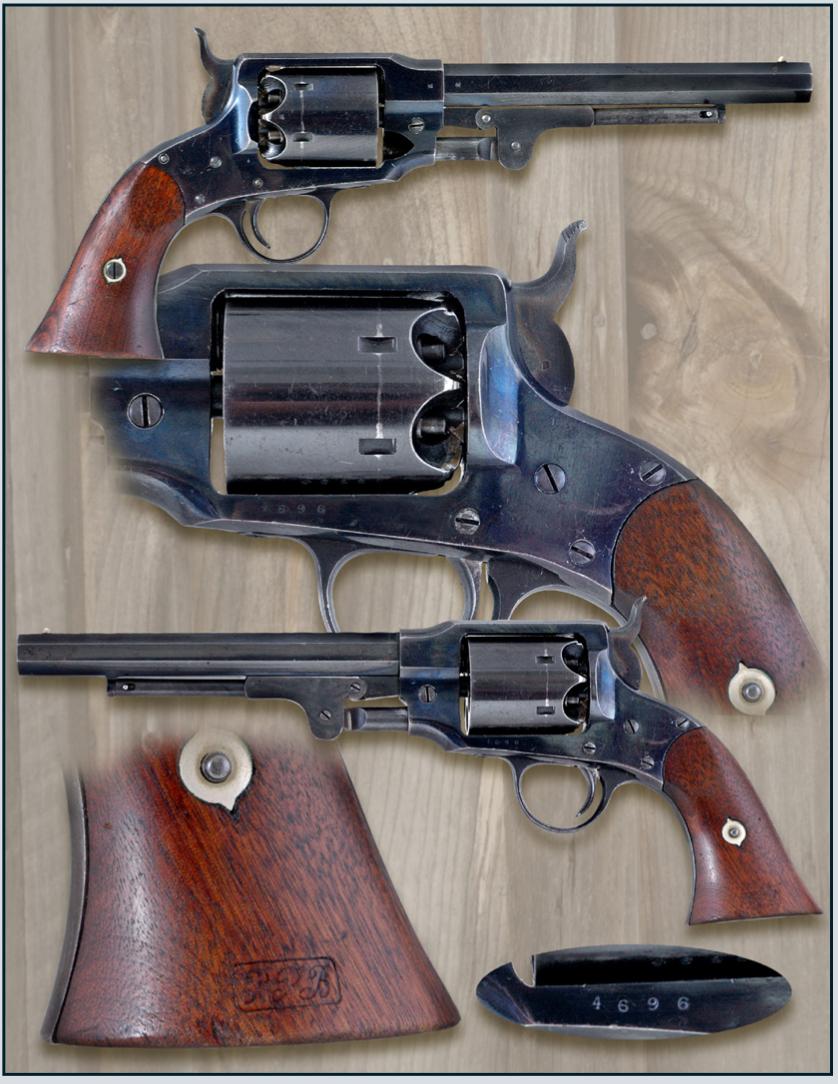 Photograph by Ron Paxton
Photograph by Ron Paxton
800 would have been for civilian use, but that figure has been questioned as low (Schiffers). Boulton records a total of 920 Rogers & Spencer revolvers as of April 1, 2019. While the highest military number is #5604, and the highest civilian number is #5581 (Table 1), the highest number he has recorded is #5853 from the grip of a mixed number rimfire conversion. That gun may have been “made up” after 1901, and is not counted in the total. We nonetheless concur with the total estimated production of about 5800. 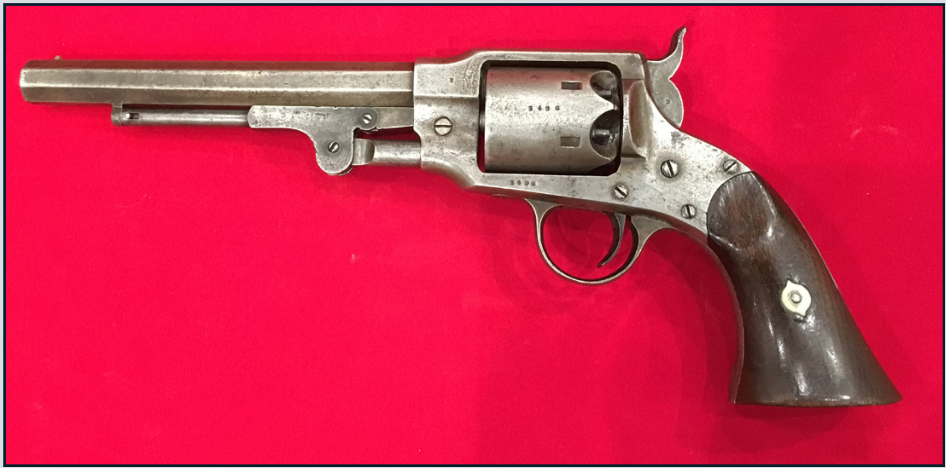 Fig. 5. The Rogers & Spencer .44 caliber percussion revolver (#3496). Noted for its “remarkably fine fit and balance” (Bannerman), it is widely considered one of the best quality revolvers of the percussion period. The entire production of 5000 martial guns sat in storage until 1901, however, accounting for the excellent condition of many specimens today. GOODSON COLLECTION.
Fig. 5. The Rogers & Spencer .44 caliber percussion revolver (#3496). Noted for its “remarkably fine fit and balance” (Bannerman), it is widely considered one of the best quality revolvers of the percussion period. The entire production of 5000 martial guns sat in storage until 1901, however, accounting for the excellent condition of many specimens today. GOODSON COLLECTION.
Boulton’s records include 737 military, 21 civilian, and 162 unconfirmed guns. There is no duplication in their serial numbers, indicating that the civilian and military revolvers were made concurrently throughout production. The fact |
|
that the lowest military numbers are #4, #15 and #17, and the lowest civilian numbers are #5 and #7, strongly suggests that the civilian guns were military rejects. The production of civilian guns clearly ramped up as the military contract neared completion. There were 8 civilian guns in the 1st thousand serial number range; 2 in the 2nd thousand; 3 in the 3rd thousand; none in the 4th thousand; but 8 in the 5th thousand. Survival Factors. The first deliveries of Rogers & Spencer revolvers occurred in January 1865. Most writers agree that they were too late for Civil War use, and that all 5000 guns went into storage. Boulton has one record of a relic dug at Appomattox Station, strongly suggesting that at least some Rogers & Spencer revolvers saw action. That battle took place on April 8, 1865. It involved about 4,000 Union troops, and resulted in 121 Union casualties (American Battlefield Trust). In addition, Schiffers recounts the story of a family with a Rogers & Spencer revolver in a military holster, attached to an officer’s waist belt. Both of these guns, however, were almost certainly civilian specimens.In October 1870 the Ordnance Department, taking advantage of the Franco-Prussian war to sell off massive stocks of surplus Civil War guns, included 5000 Rogers & Spencer revolvers in a public auction. None of them sold (McAulay 2019). Records show that they remained in storage at New York Arsenal until Francis Bannerman bought 4982 of them in 1901 (Edwards). What happened to the other eighteen guns in the interim is unknown. Bannerman catalogues offered them for sale through at least 1910, stating:
This ‘accounts for the fine to mint condition in which many specimens are seen’ today (Flayderman). The fact that these guns were stored until 1901, and were long obsolete by the time they were sold, accounts for their relatively high survival rate (15.9%). What happened to the rest of them in the 20th century is a question which this particular model is uniquely positioned to answer— especially since there is no record that Bannerman ever sold them in bulk either domestically or overseas. The fact that new specimens were recorded at an average clip of 39 per year (4.9%) indicates that many unrecorded specimens have yet to be located. |
Conclusions This installment of The Survival Files quantifies the known survival rates for the five Freeman, Pettengill and Rogers & Spencer revolvers, and the minimum Civil War survival rate for the Pettengill army. It substantially reduces the total estimated production of the .31 caliber Pettengill from 425 to just 180, and adjusts production estimates for the Pettengill navy and army down slightly to 875 and 3300, respectively. It also questions the widely reported production figure for the Freeman at 2000, suggesting that as few as 1920 may have been made. The survival rates of these Civil War-era guns appear inversely proportional to their use in the war. The highest survival rates are for the Pettengill pocket (21.7%) and Rogers & Spencer (15.9%), which saw very little if any action. The next highest rate was the Freeman (12.6%), which saw limited use via open market Army, militia and private sales. which saw very little if any action. The next highest rate was the Freeman (12.6%), which saw limited use via open market Army, militia and private sales. The lowest survival rates are for the Pettengill navy (6.5%) and army (6.0%) models. Both saw extensive use in the war, especially the .44 caliber army. Their survival rates are comparable to those of the three Civil War Starr revolvers (2.9%-5.6%) analyzed in Survival Files #1. Among other applications, the stability index for the five guns reflects how many unrecorded examples remain to be located. Just two unrecorded Pettengill pocket (1.8%), three Pettengill navy (1.8%) and fifteen Freeman revolvers (2.1%) were found from April 2016-March 2019. At the other end of the spectrum, 117 Rogers & Spencer (4.9%) and 26 Pettengill army (5.0%) revolvers were found. The Rogers & Spencer, by virtue of the fact that all of them were stored until 1901, is a uniquely interesting case for understanding the fate of the U.S. percussion revolvers in the 20th century. The well-known British arms expert Martin Pegler wrote that with the wholesale adoption of metallic cartridge handguns after the Civil War, ‘some percussion guns—like those manufactured by Freeman, Joslyn, and Rogers & Spencer—found their way to Europe. The bulk, however, were sold off for scrap.’ Pegler was contacted for this article to expand on that survival factor, but most of his files and records had unfortunately been lost to fire. Much more information is needed on the fate of U.S. percussion firearms in the 20th century, something we hope to explore in future editions of The Survival Files. |
